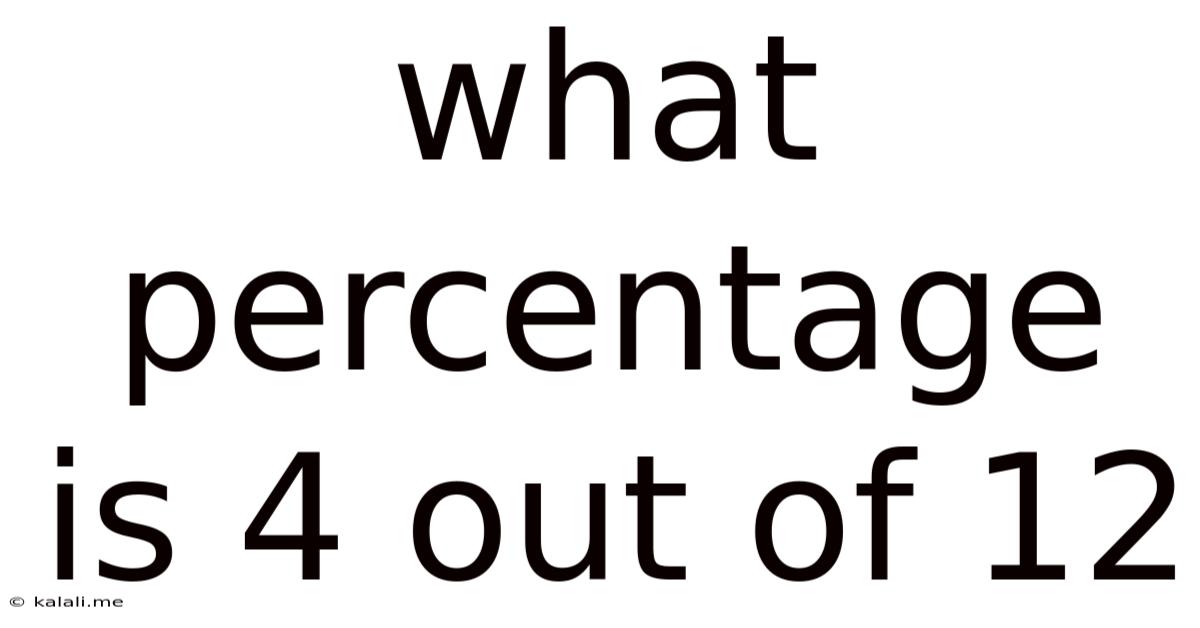What Percentage Is 4 Out Of 12
Kalali
Jul 30, 2025 · 4 min read

Table of Contents
What Percentage is 4 out of 12? A Comprehensive Guide to Percentage Calculations
Understanding percentages is a fundamental skill in many aspects of life, from calculating discounts and taxes to analyzing data and understanding statistics. This comprehensive guide will not only answer the question "What percentage is 4 out of 12?" but also equip you with the knowledge and tools to calculate any percentage effortlessly. We'll explore different methods, delve into the underlying concepts, and provide practical examples to solidify your understanding. This guide is perfect for students, professionals, and anyone looking to improve their numerical literacy.
Understanding Percentages: The Basics
A percentage is a way of expressing a number as a fraction of 100. The word "percent" itself means "out of one hundred." Therefore, 50% means 50 out of 100, which is equivalent to the fraction ½ or the decimal 0.5. Calculating percentages involves determining what proportion a given number represents relative to a whole.
Method 1: The Fraction Method
The most straightforward way to find the percentage that 4 represents out of 12 is to convert the ratio into a fraction and then into a percentage.
-
Form a Fraction: Express the given numbers as a fraction: 4/12.
-
Simplify the Fraction: Reduce the fraction to its simplest form. Both the numerator (4) and the denominator (12) are divisible by 4: 4/12 simplifies to 1/3.
-
Convert to a Decimal: Divide the numerator (1) by the denominator (3): 1 ÷ 3 ≈ 0.3333 (the 3s repeat infinitely).
-
Convert to a Percentage: Multiply the decimal by 100: 0.3333 x 100 ≈ 33.33%.
Therefore, 4 out of 12 is approximately 33.33%.
Method 2: The Proportion Method
This method utilizes the concept of proportions to solve for the unknown percentage.
-
Set up a Proportion: We can set up a proportion: x/100 = 4/12, where 'x' represents the percentage we're trying to find.
-
Cross-Multiply: Cross-multiply the terms: 12x = 400.
-
Solve for x: Divide both sides of the equation by 12: x = 400/12 ≈ 33.33.
-
Express as a Percentage: Therefore, x ≈ 33.33%.
Again, we arrive at the same conclusion: 4 out of 12 is approximately 33.33%.
Method 3: Using a Calculator
Modern calculators make percentage calculations incredibly simple. Most calculators have a percentage function (%).
-
Divide: Divide 4 by 12: 4 ÷ 12 ≈ 0.3333.
-
Multiply by 100: Multiply the result by 100: 0.3333 x 100 ≈ 33.33%.
This method offers a quick and efficient way to calculate percentages, especially for more complex scenarios.
Understanding the Significance of Recurring Decimals
Notice that in our calculations, we encountered a recurring decimal (0.3333...). This is because the fraction 1/3 cannot be expressed exactly as a finite decimal. In practical applications, rounding to a certain number of decimal places (e.g., two decimal places for 33.33%) is usually sufficient. However, for precise calculations, it's important to retain the fractional representation (1/3) or use the full recurring decimal if needed.
Real-World Applications of Percentage Calculations
Understanding percentages is essential in numerous everyday situations:
-
Sales and Discounts: Calculating discounts offered on products or services. For example, a 20% discount on a $100 item means a saving of $20.
-
Taxes: Determining the amount of tax payable on purchases or income.
-
Interest Rates: Calculating interest earned on savings accounts or paid on loans.
-
Data Analysis: Interpreting statistical data presented as percentages, such as survey results or market share.
-
Financial Statements: Understanding financial reports and analyzing key performance indicators (KPIs) expressed as percentages.
-
Grading Systems: Many educational systems use percentages to represent student performance.
Advanced Percentage Calculations: Beyond the Basics
While the examples above focus on simple percentage calculations, the principles can be extended to more complex scenarios:
-
Percentage Increase/Decrease: Calculating the percentage change between two numbers. For example, finding the percentage increase in sales from one year to the next.
-
Percentage of a Percentage: Determining a percentage of a percentage, such as calculating a discount on an already discounted item.
-
Compound Interest: Understanding how interest accumulates over time, taking into account interest earned on previously earned interest.
-
Percentage Points: Distinguishing between percentage points and percentage changes. A change from 10% to 15% is a 5 percentage point increase, but a 50% increase in the percentage.
Tips and Tricks for Mastering Percentage Calculations
-
Practice Regularly: The more you practice, the more confident and efficient you'll become.
-
Use Different Methods: Try different methods to find what works best for you.
-
Check Your Answers: Always verify your answers using a calculator or alternative method.
-
Understand the Concepts: Focus on understanding the underlying concepts rather than simply memorizing formulas.
-
Break Down Complex Problems: Break down complex problems into smaller, manageable steps.
Conclusion
This comprehensive guide has answered the initial question – 4 out of 12 is approximately 33.33% – but it has also provided you with a solid foundation in understanding and calculating percentages. From simple calculations to more advanced applications, mastering percentages is a valuable skill that will benefit you in numerous aspects of life. Remember to practice regularly and apply these techniques to real-world scenarios to further enhance your understanding and proficiency. By understanding the underlying principles and employing various calculation methods, you can confidently tackle any percentage-related problem you encounter.
Latest Posts
Latest Posts
-
How Long Can You Use Mayonnaise After The Expiration Date
Jul 31, 2025
-
How Far Is Pigeon Forge Tennessee From Nashville
Jul 31, 2025
Related Post
Thank you for visiting our website which covers about What Percentage Is 4 Out Of 12 . We hope the information provided has been useful to you. Feel free to contact us if you have any questions or need further assistance. See you next time and don't miss to bookmark.